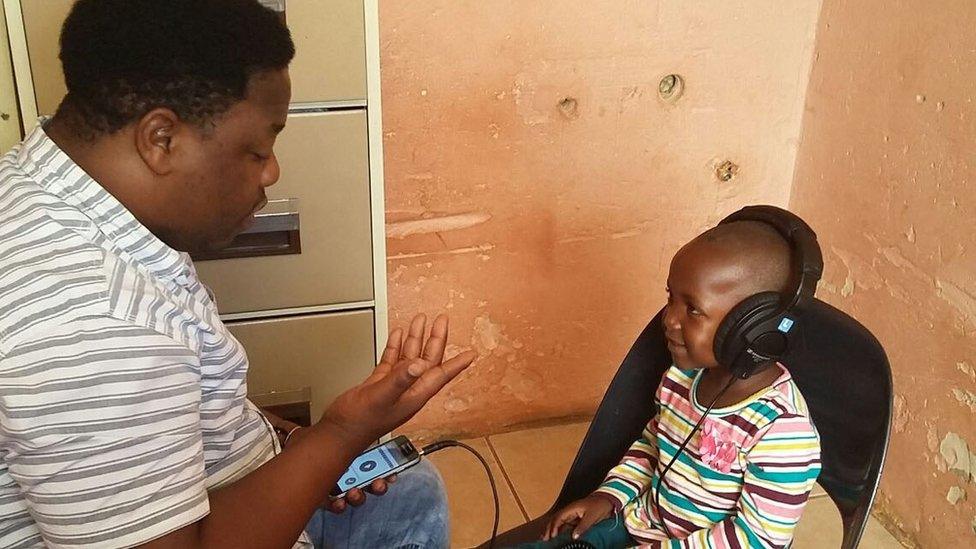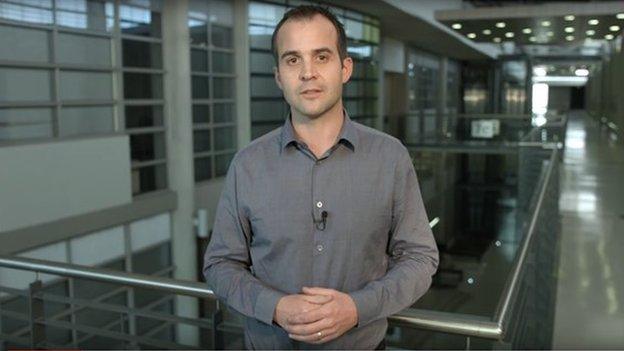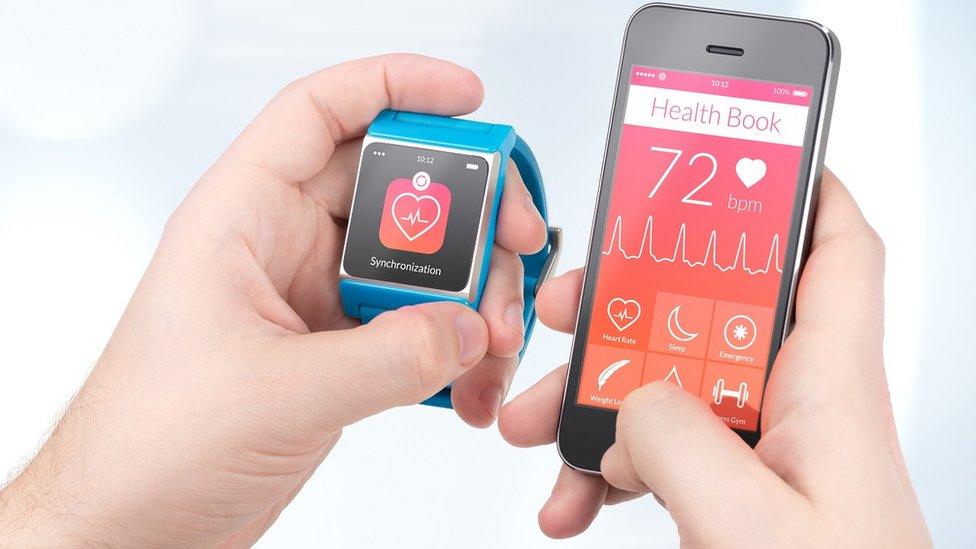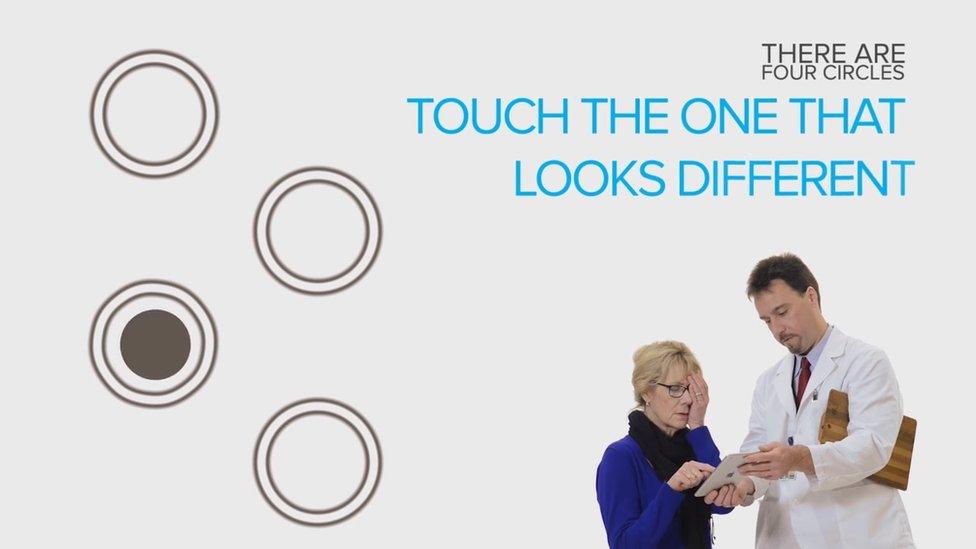The 'invisible epidemic' afflicting millions globally
- Published

The smartphone hearing test app can be operated by non-specialists
There is an "invisible epidemic" afflicting the world, but it's not contagious or infectious, and there are often no outward symptoms.
It is hearing loss - a condition that can still have profound consequences, experts say.
"Hearing loss is considered an invisible epidemic because people don't see it or know that someone suffers from it," says De Wet Swanepoel, professor of audiology at South Africa's Pretoria University.
"Not even parents may realise their child has hearing loss before critical developmental periods have lapsed."
Delays in diagnosis can affect the educational attainment and life chances of children in particular. One in 10 children globally have "educationally significant" hearing loss, says Prof Swanepoel.
The problem is that there aren't enough trained audiologists able to go out to sometimes very remote, rural areas to diagnose the condition.

Prof Swanepoel hopes his HearScreen app will extend hearing loss diagnosis to remote areas
This is where the smartphone is making a big difference.
An app called HearScreen, the result of a research project led by Prof Swanepoel and Dr Herman Myburgh at Pretoria University, can detect hearing loss with just a low-cost smartphone and a pair of headphones.
Complete with real-time background noise monitoring, the app turns a mobile phone's microphone into a calibrated sound level meter.
You put the headphones on, and the tester, sitting behind you, uses the phone to send audio beeps at different volumes to your ears. If you can hear them you raise your hand and the tester records your responses.
It's all very simple - the app can screen two ears in less than 60 seconds and its makers claim that the system is six times cheaper than traditional testing equipment.
The data captured is stored to the cloud where specialists can access and analyse it remotely.
The "clinically validated" app can be operated effectively by non-specialists, the company says, making it ideally suited for use in remote locations.

HearScreen says the app conforms to international standards
"More than 80% of the app's usage is in underserved and rural areas," says Prof Swanepoel, "providing many populations with access to hearing testing for the first time."
If a test diagnoses hearing loss, the app can refer the patient by text to the closest healthcare facility for follow-up services.
Shannon Kruyt, an audiologist at HearInAfrica, which provides hearing care in schools in a number of African countries, knows all about this "invisible epidemic".
She says: "[HearScreen] is improving my work because the screening of hearing can now be done at a community-based level, without audiologists needing to go out into the field.
"The biggest challenge we are facing is the disparity between the shortage of audiologists and prevalence of hearing loss in Africa. HearScreen has been a massive game changer."
The app has also won the approval of partners such as the World Health Organization (WHO) and USAID.
A question of trust
But how much should we trust such diagnostic apps, however well-intended?
Dr Shelly Chadha, technical officer for deafness and hearing at the WHO, says: "Mobile apps can serve a very useful role in raising awareness about hearing and making hearing care more accessible.
"But if a mobile app for hearing assessment is not accurate this can give incorrect information to the user, which can be harmful."
HearScreen maintains that its app conforms to ISO calibration standards and compares favourably to traditional audiometry equipment.

There are thousands of health apps on the market, but how accurate are they?
But the WHO is concerned that other diagnostic apps may not have been systematically evaluated or clinically proven to work effectively and safely.
There are 259,000 health apps available to consumers globally, according to a recent study by the health research group Research2Guidance, measuring everything from heart health to female fertility, asthma to diabetes.
IBM and its Watson supercomputer are getting better at identifying skin cancer, external from photos taken by a smartphone equipped with a special camera, but even it admits that "work is still in its early stages".
And while the potential benefits of the smartphone "pocket doctor" are indisputable - remote monitoring by doctors being a major one - there is also the danger of mis-diagnosis and incorrect self-treatment if the apps are not proven.
This is why regulatory approval and an evidence-based approach is so important.
For example, US-based eye testing app mVT Service has been approved by the Food and Drug Administration (FDA) and wears this endorsement like a badge of honour.
The app is prescribed to patients via their doctors and enables patients to monitor their eyesight from the comfort of their own homes.

The mVT Service app is simple to use so eye patients can test themselves
"Our goal is to reduce vision blindness by actively monitoring the patient's home vision test results and alerting the patient's licensed eye-care doctor of any significant vision function change," says myVisionTrack chief marketing officer George Mavro.
Currently launching with a select group of specialists and 98% effective at detecting changes in vision, mVT Service uses a smartphone app and eye patch to test patients.
All users have to do is look at a choice of shapes and select the one that looks different. Results are then shared with their doctor via the cloud.
"The goal of the service is to reduce vision blindness by actively monitoring the patient's home vision test results and alerting the patient's prescriber to any significant vision function change," Mr Mavro says.
Obviously, the earlier we can detect potential problems the better.
Organisations such as the WHO are working hard on assessing the quality of individual apps, and giving their blessing to the relevant ones.
For the good of healthcare worldwide, sorting the good from the bad will be key if mHealth is to fulfil its promise.

Follow Technology of Business editor Matthew Wall on Twitter, external and Facebook, external
Click here for more Technology of Business features, external